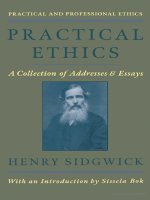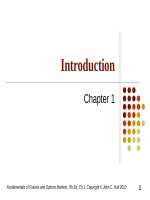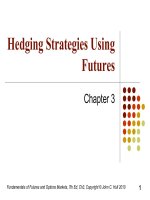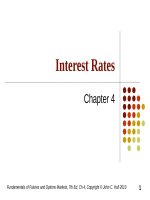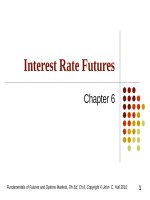Practical process control fundamentals of instrumentation and process control
Bạn đang xem bản rút gọn của tài liệu. Xem và tải ngay bản đầy đủ của tài liệu tại đây (2.61 MB, 166 trang )
®
Control Station
Innovative Solutions from the Process Control Professionals
©
Practical Process Control
“Fundamentals of Instrumentation and Process Control
Practical Process Controlđ
Copyright â 2005 by Control Station, Inc.
All Rights Reserved
Practical Process Control
“Fundamentals of Instrumentation and Process Control”
Copyright © 2005 by Control Station, Inc.
All rights reserved. No portion of this
book may be reproduced in any form or
by any means except with the explicit,
prior, written permission of Control
Station, Inc.
Practical Process Control®
Copyright © 2005 by Control Station, Inc.
All Rights Reserved
Table of Contents
Table of Contents .................................................................................................................................................. 3
1. Introduction to Process Control.................................................................................................. 1
Objectives:...................................................................................................................................... 1
Introduction ................................................................................................................................ 2
Why do we need Process Control? ........................................................................................................................ 2
Safety................................................................................................................................................................ 2
Quality .............................................................................................................................................................. 2
Profit ................................................................................................................................................................. 2
What is a Process? ................................................................................................................................................. 4
What is Process Control?....................................................................................................................................... 5
Basics of Process Control........................................................................................................... 8
What is Open Loop Control?................................................................................................................................. 8
What are the Modes of Closed Loop Control? .................................................................................................... 12
Manual Control............................................................................................................................................... 12
On-Off Control ............................................................................................................................................... 13
PID Control .................................................................................................................................................... 15
Time Proportion Control................................................................................................................................. 16
What are the Basic Elements of Process Control?............................................................................................... 17
The Process..................................................................................................................................................... 18
Sensors............................................................................................................................................................ 18
Final Control Elements ................................................................................................................................... 18
The Controller ................................................................................................................................................ 18
Process Characteristics .................................................................................................................. 19
Objectives:.................................................................................................................................... 19
Introduction: Process Order...................................................................................................... 19
First Order Processes................................................................................................................ 20
Lesson 1. What is a First Order Process? .......................................................................................................... 20
What is Process Dead Time? ............................................................................................................................... 21
Measuring Dead time...................................................................................................................................... 21
What is the Process Time Constant? ................................................................................................................... 22
Measuring the Time Constant......................................................................................................................... 22
Controllability of a Process ............................................................................................................................ 23
What is Process Gain? ......................................................................................................................................... 24
Measuring Process Gain ................................................................................................................................. 24
Making Gains Unitless ................................................................................................................................... 25
Values for Process Gain.................................................................................................................................. 26
What is Process Action? ...................................................................................................................................... 27
Process Action and Controller Action ............................................................................................................ 27
Process Orders ................................................................................................................................. 28
Higher Order Processes ............................................................................................................ 28
What are Higher Order Processes? ...................................................................................................................... 28
Over-damped Response .................................................................................................................................. 29
First Order Fit of Higher Order Over-Damped Processes............................................................................... 30
First Order Fit of Higher Order Under-Damped Response ............................................................................. 31
Critically Damped Response .......................................................................................................................... 32
What is a Linear Process?.................................................................................................................................... 33
What is a Nonlinear Process? .............................................................................................................................. 34
Dealing with Nonlinearity .............................................................................................................................. 35
Disturbance Rejection................................................................................................................................ 35
Set Point Response..................................................................................................................................... 36
Process Type............................................................................................................................. 37
What are Self-Regulating Processes? .................................................................................................................. 37
What are Integrating Processes?.......................................................................................................................... 38
Dead time, Time Constants and Gain in an Integrating Process ..................................................................... 39
Practical Process Controlđ
Copyright â 2005 by Control Station, Inc.
All Rights Reserved
Dead Time in an Integrating Process ......................................................................................................... 39
Time Constants in an Integrating Process .................................................................................................. 39
Gain in an Integrating Process ................................................................................................................... 39
Introduction to Instrumentation ................................................................................................... 42
Objectives:.................................................................................................................................... 42
Instrumentation Basics ............................................................................................................. 43
What are Sensors and Transducers? .................................................................................................................... 43
Sensors............................................................................................................................................................ 43
Transducers..................................................................................................................................................... 44
What are the Standard Instrumentation Signals................................................................................................... 45
Pneumatic ....................................................................................................................................................... 45
Current Loop .................................................................................................................................................. 46
Loop Scaling.............................................................................................................................................. 46
Output Scaling ...................................................................................................................................... 46
Input Scaling ......................................................................................................................................... 46
0 - 10 V........................................................................................................................................................... 46
What are Smart Transmitters? ............................................................................................................................. 47
Digital Communications ................................................................................................................................. 47
Configuration.................................................................................................................................................. 47
Signal Conditioning ........................................................................................................................................ 47
Self-Diagnosis ................................................................................................................................................ 47
What Instrument Properties Affect a Process? .................................................................................................... 48
Range and Span .............................................................................................................................................. 48
Match Range to Expected Conditions........................................................................................................ 48
Measurement Resolution ................................................................................................................................ 49
Accuracy and Precision .................................................................................................................................. 50
% Error Over a Range................................................................................................................................ 50
Absolute Over a Range .............................................................................................................................. 50
Accuracy vs. Precision............................................................................................................................... 51
Instrumentation Dynamics.............................................................................................................................. 52
Instrument Gain ......................................................................................................................................... 52
Instrument Time Constants ........................................................................................................................ 52
Instrument Dead Time ............................................................................................................................... 52
What is Input Aliasing? ....................................................................................................................................... 53
Correct Sampling Frequency .......................................................................................................................... 54
Determining the Correct Sampling Interval.................................................................................................... 55
What is Instrument Noise? .................................................................................................................................. 56
Effects of Noise .............................................................................................................................................. 56
Eliminating Noise ........................................................................................................................................... 57
Low Pass Filters .................................................................................................................................... 57
Selecting a Filter by Cut-off Frequency................................................................................................ 57
Selecting a Filter by Time Constant...................................................................................................... 58
Selecting a Filter by Alpha Value ......................................................................................................... 59
Process Instrumentation............................................................................................................ 60
What is Temperature?.......................................................................................................................................... 60
Units of Temperature...................................................................................................................................... 60
What Temperature Instruments Do We Use? ...................................................................................................... 61
Thermocouples ............................................................................................................................................... 61
Junctions .................................................................................................................................................... 61
Junction Misconceptions....................................................................................................................... 62
Lead Wires ............................................................................................................................................ 62
Linearization .............................................................................................................................................. 63
Gain ........................................................................................................................................................... 63
Thermocouple Types ................................................................................................................................. 64
Resistive Temperature Devices ...................................................................................................................... 65
The Importance of the Temperature Coefficient alpha .............................................................................. 65
Lead Wire Resistance ................................................................................................................................ 66
2 Wire RTDs ......................................................................................................................................... 66
3 Wire RTDs ......................................................................................................................................... 67
Practical Process Controlđ
Copyright â 2005 by Control Station, Inc.
All Rights Reserved
Self Heating ............................................................................................................................................... 67
Thermistors..................................................................................................................................................... 68
Infrared ........................................................................................................................................................... 69
Emittance ................................................................................................................................................... 69
Field of View ............................................................................................................................................. 70
Spectral Response ...................................................................................................................................... 70
What is Pressure? ................................................................................................................................................ 71
Units of Pressure............................................................................................................................................. 71
Absolute, Gauge and Differential Pressure..................................................................................................... 71
What is Level?..................................................................................................................................................... 73
Point and Continuous Level............................................................................................................................ 73
Common Level Sensing Technologies ................................................................................................................ 74
Non-Contact Level Measurement ................................................................................................................... 74
Ultrasonic Measurement ............................................................................................................................ 74
Radar / Microwave..................................................................................................................................... 74
Nuclear Level Sensor................................................................................................................................. 75
Contact Level Measurement ........................................................................................................................... 76
Pressure Measurement ............................................................................................................................... 76
RF Capacitance / Resistance...................................................................................................................... 77
Guided Wave Radar................................................................................................................................... 78
What is Flow?...................................................................................................................................................... 79
Factors Affecting Flow Measurement............................................................................................................. 79
Viscosity .................................................................................................................................................... 79
Temperature and Pressure Effects on Viscosity.................................................................................... 80
Units of Viscosity ................................................................................................................................. 80
Viscosities and Densities of Common Household Fluids...................................................................... 81
Conversion Tables................................................................................................................................. 82
Fluid Type.................................................................................................................................................. 84
Newtonian Fluids .................................................................................................................................. 84
Non-Newtonian Fluids .......................................................................................................................... 84
Reynolds Number ...................................................................................................................................... 85
Laminar Flow........................................................................................................................................ 85
Turbulent Flow...................................................................................................................................... 86
Transitional Flow .................................................................................................................................. 86
Flow Irregularities...................................................................................................................................... 87
Common Flow Instruments ................................................................................................................................. 88
Units of Volumetric Flow .......................................................................................................................... 90
Positive Displacement Flow Meters........................................................................................................... 91
Magnetic Flow Meters ............................................................................................................................... 91
Orifice Plate**................................................................................................................................................ 91
Orifice Plate**................................................................................................................................................ 92
Units of Mass Flow.................................................................................................................................... 94
Coriolis Flow Meters ................................................................................................................................. 94
Turndown ....................................................................................................................................................... 95
Installation and Calibration............................................................................................................................. 95
Valves....................................................................................................................................... 97
What is a Control Valve? .................................................................................................................................... 97
Shut-Off Service ............................................................................................................................................. 97
Divert Service ................................................................................................................................................. 97
Throttling Service ........................................................................................................................................... 97
Parts of a Control Valve ................................................................................................................................. 98
What is an Actuator? ........................................................................................................................................... 99
What is a Positioner? ......................................................................................................................................... 100
What is Cv?........................................................................................................................................................ 101
What are Valve Characteristics?........................................................................................................................ 102
Inherent Characteristics ................................................................................................................................ 102
Rangeability............................................................................................................................................. 103
Gain ......................................................................................................................................................... 103
Equal Percentage Valves.......................................................................................................................... 104
Linear Valves........................................................................................................................................... 105
Quick Opening Valves............................................................................................................................. 105
Practical Process Controlđ
Copyright â 2005 by Control Station, Inc.
All Rights Reserved
Installed ........................................................................................................................................................ 106
What is Valve Deadband ................................................................................................................................... 108
Testing for Deadband ................................................................................................................................... 109
Method A ................................................................................................................................................. 109
Method B ................................................................................................................................................. 110
Effects of Deadband ..................................................................................................................................... 110
What is Stiction? ............................................................................................................................................... 111
Testing for Stiction ....................................................................................................................................... 112
Effects of Stiction ......................................................................................................................................... 112
What are the Types of Valves?.......................................................................................................................... 113
Linear Motion ............................................................................................................................................... 113
Globe Valve ............................................................................................................................................. 113
Gate Valve ............................................................................................................................................... 114
Diaphragm Valve..................................................................................................................................... 114
Pinch Valve.............................................................................................................................................. 115
Rotary Motion .............................................................................................................................................. 116
Ball Valve ................................................................................................................................................ 116
Butterfly Valve ........................................................................................................................................ 116
Plug Valve ............................................................................................................................................... 117
Pumps ..................................................................................................................................... 118
What is a Centrifugal Pump?............................................................................................................................. 118
What is Pump Head? ......................................................................................................................................... 119
Why Do We Use Head and Not PSI? ................................................................................................................ 120
What is a Pump Curve? ..................................................................................................................................... 121
What is a System Curve?................................................................................................................................... 122
What is the System Operating Point? ................................................................................................................ 123
Throttling Valves.......................................................................................................................................... 124
Variable Frequency Drives ........................................................................................................................... 125
Speed - Capacity Relationship ................................................................................................................. 125
Speed - Head Relationship....................................................................................................................... 125
Speed - Horsepower Relationship............................................................................................................ 126
What is a Positive Displacement Pump? ........................................................................................................... 128
How Does a PD Pump Differ From a Centrifugal Pump? ................................................................................. 128
Pump Head ................................................................................................................................................... 128
Pump Curve .................................................................................................................................................. 129
Changing the System Operating Point.......................................................................................................... 129
Variable Frequency Drives ...................................................................................................................... 130
Speed - Capacity Relationship ............................................................................................................ 130
Speed - Horsepower Relationship ....................................................................................................... 130
The PID Controller....................................................................................................................... 131
Objectives:.................................................................................................................................. 131
The Many Faces of PID.......................................................................................................... 132
What are the PID Equations?............................................................................................................................. 132
Series ............................................................................................................................................................ 132
Dependent..................................................................................................................................................... 133
Independent .................................................................................................................................................. 134
PID Control Modes ................................................................................................................ 135
What are the Modes of Operation? .................................................................................................................... 135
What is Proportional Control? ........................................................................................................................... 136
Bias............................................................................................................................................................... 136
Controller Gain, Proportional Gain or Proportion Band ............................................................................... 136
Controller Action.......................................................................................................................................... 137
Process Nonlinearity..................................................................................................................................... 138
What is Integral Control? .................................................................................................................................. 139
Repeats, Integral or Reset? ........................................................................................................................... 141
Integral Windup............................................................................................................................................ 142
What is Derivative? ........................................................................................................................................... 143
Derivative Filter............................................................................................................................................ 144
Derivative Kick............................................................................................................................................. 146
Practical Process Controlđ
Copyright â 2005 by Control Station, Inc.
All Rights Reserved
What is Loop Update Time?.............................................................................................................................. 147
What Combinations of Control Action Can I Use? ........................................................................................... 148
Proportional Only ......................................................................................................................................... 148
Proportional + Derivative ............................................................................................................................. 148
Integral Only................................................................................................................................................. 148
Proportional + Integral.................................................................................................................................. 148
Full PID ........................................................................................................................................................ 148
Fundamentals of Loop Tuning .................................................................................................... 150
Objectives:.................................................................................................................................. 150
Introduction ............................................................................................................................ 151
What is the Goal of Tuning?.............................................................................................................................. 151
Operate Within Safe Constraints of the Process ...................................................................................... 151
Maximize Operating Profit ...................................................................................................................... 151
Eliminate offset from Set Point................................................................................................................ 151
Be stable over the normal operating range............................................................................................... 151
Avoid excessive control action (not overstress the final control element)............................................... 152
The Approach ............................................................................................................................................... 152
How Do You Tune by Trial and Error?.................................................................................. 153
Trial and Error, Proportional First ................................................................................................................ 153
Trial and Error, Integral First........................................................................................................................ 154
Rules of Thumb ...................................................................................................................... 155
Good Practice and Troubleshooting ........................................................................................... 156
Common Control Loops ......................................................................................................... 156
Flow Control................................................................................................................................................. 156
Level Control................................................................................................................................................ 156
Pressure Control ........................................................................................................................................... 156
Temperature Control..................................................................................................................................... 156
Troubleshooting...................................................................................................................... 157
Check each subsystem separately ................................................................................................................. 157
Final Control Elements ................................................................................................................................. 157
Common Valve Problems ........................................................................................................................ 157
Sensors.......................................................................................................................................................... 158
Common sensor Problems ....................................................................................................................... 158
Smart Transmitters.............................................................................................................................. 158
Temperature Sensors........................................................................................................................... 158
Pressure Sensors.................................................................................................................................. 158
Flow Sensors....................................................................................................................................... 158
The Controller .............................................................................................................................................. 159
Common Controller Problems ................................................................................................................. 159
The Process................................................................................................................................................... 159
Common Process Problems ..................................................................................................................... 159
Practical Process Controlđ
Copyright â 2005 by Control Station, Inc.
All Rights Reserved
1. Introduction to Process Control
Objectives:
In this chapter you will learn:
Why Do We Need Process Control?
What is a Process?
What is Process Control?
What is Open Loop Control?
What is Closed Loop Control?
What are the Modes of Control?
What are the Basic Elements of Process Control?
1
Practical Process Controlđ
Copyright â 2005 by Control Station, Inc.
All Rights Reserved
Introduction
Why do we need Process Control?
Effective process control is required to maintain safe operations, quality products, and business
viability.
Safety
The primary purpose of a Process Control system is safety: personnel safety, environmental
safety and equipment safety. The safety of plant personnel and the community is the highest
priority in any operation. An example of safety in a common heat exchanger process is the
installation of a pressure relief valve in the steam supply. Other examples of safety incorporated
into process control systems are rupture disks and blow out panels, a pressure switch that does not
allow a pump to over pressurize a pipe or a temperature switch that does not allow the fluid
flowing through a heat exchanger to overheat.
Quality
In addition to safety, process control systems are central to maintaining product quality. In
blending and batching operations, control systems maintain the proper ratio of ingredients to
deliver a consistent product. They tightly regulate temperatures to deliver consistent solids in
cooking systems. Without this type of control, products would vary and undermine quality.
Profit
When safety and quality concerns are met, process control objectives can be focused on profit.
All processes experience variations and product quality demands that we operate within
constraints. A batch system may require +- 0.5% tolerance on each ingredient addition to
maintain quality. A cook system may require +- 0.5 degrees on the exit temperature to maintain
quality. Profits will be maximized the closer the process is operated to these constraints. The real
challenge in process control is to do so safely without compromising product quality.
2
Practical Process Controlđ
Copyright â 2005 by Control Station, Inc.
All Rights Reserved
Figure 1-1 Copyright Control Station
Figure 1-2 Copyright Control Station
3
Practical Process Controlđ
Copyright â 2005 by Control Station, Inc.
All Rights Reserved
What is a Process?
"A process is broadly defined as an operation that uses resources to transform inputs
into outputs. It is the resource that provides the energy into the process for the
transformation to occur.
Figure 1-3
Figure 1-4 shows a hot water generation process commonly found in plants. The input to this
process is cold water and the output of the process is hot water. Steam is the resource that
provides energy for the transformation to occur within the heat exchanger plates.
Figure 1-4
4
Practical Process Control®
Copyright © 2005 by Control Station, Inc.
All Rights Reserved
Most plants operate multiple types of processes, including separation, blending, heating, and
cooling to name a few. Each process exhibits a particular dynamic (time varying) behavior that
governs the transformation, that is, how do changes in the resource or inputs over time affect the
transformation. This dynamic behavior is determined by the physical properties of the inputs, the
resource and the process itself. A typical heat exchanger process contains a plate and frame heat
exchanger to transfer the heat from the steam to the incoming water. The properties of the
incoming water (temperature), the steam (pressure) and properties of the specific heat exchanger
used (surface area, efficiency of heat transfer) will determine the dynamic behavior, that is; how
will the output be affected by changes in water temperature or steam pressure (flow)?
What is Process Control?
"Process control is the act of controlling a final control element to change the
manipulated variable to maintain the process variable at a desired Set Point.
A corollary to the definition of process control is a controllable process must behave in a
predictable manner. For a given change in the manipulated variable the process variable must
respond in a predictable and consistent manner. Following are definitions of some terms we will
be using in out discussion of process control:
"The manipulated variable (MV) is a measure of resource being fed into the process,
for instance how much thermal energy.
"A final control element (FCE) is the device that changes the value of the
manipulated variable.
"The controller output (CO) is the signal from the controller to the final control
element.
"The process variable (PV) is a measure of the process output that changes in
response to changes in the manipulated variable.
"The Set Point (SP) is the value at which we whish to maintain the process variable
at.
5
Practical Process Controlđ
Copyright â 2005 by Control Station, Inc.
All Rights Reserved
Figure 1-5 shows a block diagram of a process with a final control element and sensors to
measure the manipulated variable and process variable. In single loop control systems the actual
value of the manipulated variable is often not measured, the value of the process variable is the
only concern.
Figure 1-5
Figure 1-6 shows a heat exchanger. We see that the manipulated variable (MV) is steam
pressure. The final control element is the valve, by changing the valve opening we are changing
the flow of steam which we can measure by its pressure. The process variable (PV) is the
temperature of the water exiting the heat exchanger; this is the measure of the process output that
responds to changes in the flow of steam.
6
Practical Process Controlđ
Copyright â 2005 by Control Station, Inc.
All Rights Reserved
Figure 1-6
This is a controllable process because opening the valve will always lead to an increase in
temperature, conversely closing the valve will always lead to a decrease in temperature. If this
were not true, if sometimes on closing the valve we had an increase in temperature, the process
would not be controllable.
7
Practical Process Controlđ
Copyright â 2005 by Control Station, Inc.
All Rights Reserved
Basics of Process Control
What is Open Loop Control?
"In open loop control the controller output is not a function of the process variable.
In open loop control we are not concerned that a particular Set Point be maintained, the controller
output is fixed at a value until it is changed by an operator. Many processes are stable in an open
loop control mode and will maintain the process variable at a value in the absence of a
disturbance.
"Disturbances are uncontrolled changes in the process inputs or resources.
However, all processes experience disturbances and with open loop control this will always result
in deviations in the process variable; and there are certain processes that are only stable at a given
set of conditions and disturbances will cause these processes to become unstable. But for some
processes open loop control is sufficient. Cooking on a stove top is an obvious example. The
cooking element is fixed at high, medium or low without regard to the actual temperature of what
we are cooking. In these processes, an example of open loop control would be the slide gate
position on the discharge of a continuous mixer or ingredient bin.
8
Practical Process Controlđ
Copyright â 2005 by Control Station, Inc.
All Rights Reserved
Figure 1-8 depicts the now familiar heat exchanger. This is a stable process, and given no
disturbances we would find that the process variable would stabilize at a value for a given valve
position, say 110°F when the valve was 50% open. Furthermore, the temperature would remain
at 110°F as long as there were no disturbances to the process.
Figure 1-7
However, if we had a fluctuation in steam supply pressure, or if the temperature of the water
entering the heat exchanger were to change (this would be especially true for recirculation
systems with a sudden change in demand) we would find that the process would move to a new
point of stability with a new exit temperature.
9
Practical Process Controlđ
Copyright â 2005 by Control Station, Inc.
All Rights Reserved
What is Closed Loop Control?
"In closed loop control the controller output is determined by difference between the
process variable and the Set Point. Closed loop control is also called feedback or
regulatory control
The output of a closed loop controller is a function of the error.
"Error is the deviation of the process variable from the Set Point and is defined as
E = SP - PV.
A block diagram of a process under closed loop control is shown in figure 1-9.
Figure 1-8
10
Practical Process Controlđ
Copyright â 2005 by Control Station, Inc.
All Rights Reserved
Figure 1-10 depicts the heat exchanger under closed loop control.
"An important point of this illustration is that the process, from the controller’s
perspective, is larger than just the transformation from cold to hot water within the
heat exchanger. From the controllers perspective the process encompasses the RTD,
the steam control valve and signal processing of the PV and CO values.
How the valve responds to the controller output and its corresponding effect on the manipulated
variable (steam pressure) will determine the final effect on the process variable (temperature).
The quality and responsiveness of the temperature measurement directly effects how the
controller sees its effect on the process. Any filtering to diminish the effects of noise will paint a
different picture of the process that the controller sees.
The dynamic behaviors of all of the elements in a control loop superimpose to form a single
image of the process that is presented to the controller. To control the process requires some
understanding of each of these elements.
Figure 1-9
11
Practical Process Controlđ
Copyright â 2005 by Control Station, Inc.
All Rights Reserved
What are the Modes of Closed Loop Control?
Closed loop control can be Manual, On-Off, PID, Advanced PID (ratio, cascade, feed-forward) or
Model Based depending on the algorithm that determines the controller output based on the error.
Manual Control
"In manual control an operator directly manipulates the controller output to the final
control element to maintain a Set Point.
In Figure 1-11 we have placed an operator at the steam valve of the heat exchanger. Their only
duty is to look at the temperature of the water exiting the heat exchanger and adjust the steam
valve accordingly; we have a manual control system.
While such a system would work, it is costly (we're employing someone to just turn a valve), the
effectiveness depends on the experience of the operator, and as soon as the operator walks away
we are in open loop.
Figure 1-10
12
Practical Process Controlđ
Copyright â 2005 by Control Station, Inc.
All Rights Reserved
On-Off Control
"On-Off control provides a controller output of either on or off in response to error.
As an on-off controller only proves a controller output hat is either on or off, on-off control
requires final control elements that have two command positions: on-off, open-closed.
In Figure 1-12 we have replaced the operator with a thermostat and installed an open-close
actuator on the steam valve, we have implemented on-off control.
Figure 1-11
13
Practical Process Controlđ
Copyright â 2005 by Control Station, Inc.
All Rights Reserved
As the controller output can only be either on or off, the steam control valve will be either open
or closed depending on the thermostat's control algorithm. For this example we know the
thermostat's controller output must be on when the process variable is below the Set Point; and
we know the thermostat's controller output must be off when the process variable is above the Set
Point.
But what about when the process variable is equal to the Set Point? The controller output cannot
be both on and off.
On-off controllers separate the point at which the controller changes its output by a value called
the deadband (see Figure 1-13).
"Upon changing the direction of the controller output, deadband is the value that
must be traversed before the controller output will change its direction again.
Figure 1-12
On the heat exchanger, if the thermostat is configured with a 110°F Set Point and a 20°F
deadband, the steam valve will open at 100°F and close at 120°F. If such a large fluctuation from
the Set Point is acceptable, then the process is under control.
If this fluctuation is not acceptable we can decrease the deadband, but in doing so the steam valve
will cycle more rapidly, increasing the wear and tear on the valve, and we will never eliminate the
error (remember, the thermostat cannot be both on and off at 110F).
14
Practical Process Controlđ
Copyright â 2005 by Control Station, Inc.
All Rights Reserved
PID Control
"PID control provides a controller output that modulates from 0 to 100% in response
to error.
As an on-off controller only proves a controller output that is either on or off, on-off control
requires devices that have two command positions: on-off, open-closed.
As a PID controller provides a modulating controller output, PID control requires final control
elements that have can accept a range of command values, such as valve position or pump speed.
"To modulate is to vary the amplitude of a signal or a position between two fixed
points.
The advantage of PID control over on-off Control is the ability to operate the process with
smaller error (no deadband) with less wear and tear on the final control elements.
Figure 1-13
15
Practical Process Controlđ
Copyright â 2005 by Control Station, Inc.
All Rights Reserved
Time Proportion Control
"Time proportion control is a variant of PID control that modulates the on-off time of
a final control element that only has two command positions.
To achieve the effect of PID control the switching frequency of the device is modulated in
response to error. This is achieved by introducing the concept of cycle time.
Cycle Time is the time base of the signal the final control element will receive from the
controller. The PID controller determines the final signal to the controller by multiplying the
cycle time by the output of the PID algorithm.
In Figure 1-15 we have a time proportion controller with a cycle time of 10 seconds. When the
PID algorithm has an output of 100% the signal to the final control element will be on for 10
seconds and then repeat. If the PID algorithm computes a 70% output the signal to the final
control element will be on for 7 seconds and off for 3 and then repeat.
Figure 1-14
While time proportion control can give you the benefits of PID control with less expensive final
control elements it does so at the expense of wear and tear on those final control elements.
Where used, output limiting should be configured on the controller to inhibit high frequency
switching of the final control element at low controller outputs.
16
Practical Process Controlđ
Copyright â 2005 by Control Station, Inc.
All Rights Reserved
What are the Basic Elements of Process Control?
"Controlling a process requires knowledge of four basic elements, the process itself,
the sensor that measures the process value, the final control element that changes
the manipulated variable, and the controller.
Figure 1-15
17
Practical Process Controlđ
Copyright â 2005 by Control Station, Inc.
All Rights Reserved
The Process
We have learned that processes have a dynamic behavior that is determined by physical
properties; as such they cannot be altered without making a physical change to the process. We
will be learning more about process dynamics in Chapter 2.
Sensors
Sensors measure the value of the process output that we wish to effect. This measurement is
called the Process Variable or PV. Typical Process Variables that we measure are temperature,
pressure, mass, flow and level. The Sensors we use to measure these values are RTDs, pressure
gauges and transducers, load cells, flow meters and level probes. We will be learning more about
sensors in Chapter 3.
Final Control Elements
A Final Control Element is the physical device that receives commands from the controller to
manipulate the resource. Typical Final Control Elements used in these processes are valves and
pumps. We will be learning more about final control elements in Chapter 4.
The Controller
A Controller provides the signal to the final element. A controller can be a person, a switch, a
single loop controller, or DCS / PLC system. We will be learning more about PID controllers in
Chapter 5. We will be learning about tuning PID controllers in Chapter 6.
18
Practical Process Controlđ
Copyright â 2005 by Control Station, Inc.
All Rights Reserved

